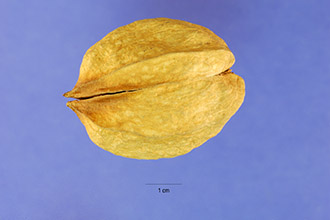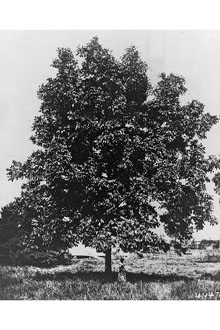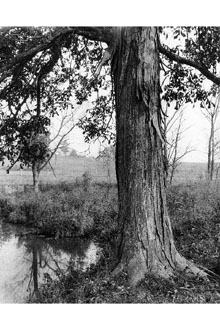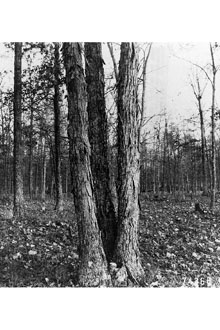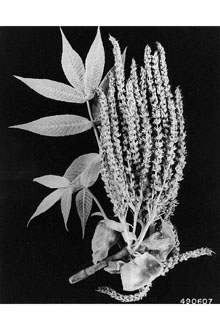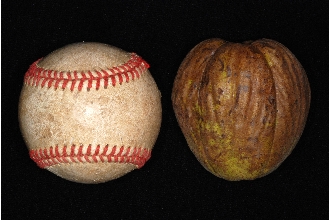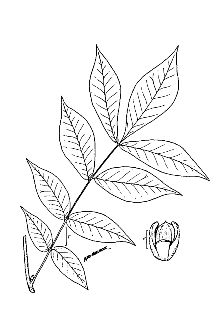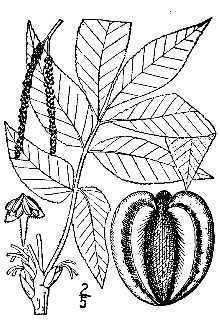Shellbark Hickory
Scientific Name: Carya laciniosa (Michx. f.) G. Don
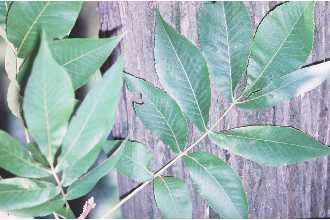
| General Information | |
|---|---|
| Usda Symbol | CALA21 |
| Group | Dicot |
| Life Cycle | Perennial |
| Growth Habits | Tree |
| Native Locations | CALA21 |
Plant Guide
Alternate Names
Big shellbark, bottom shellbark, thick shellbark, western shellbark, shagbark hickory, bigleaf shagbark hickory, kingnut
Uses
The wood of shellbark hickory is hard, heavy, strong, and very flexible, making it a favored wood for tool handles, The hardness and beauty of the grain also make it desired for furniture, cabinets, and veneer, All hickories, however, suffer from ring shake, a separation of wood along the annual rings and a serious problem for thin veneers, It also is prized as fuelwood and charcoal, The nuts of shellbark hickory are sweet and edible and the largest of all hickories, Use soil moisture sensors to measure the soil moisture of Shellbark Hickory., They are eaten by a wide range of wildlife species, including ducks, quail, wild turkeys, squirrels, chipmunks, deer, foxes, raccoons, and white-footed mice, The tree is rarely planted as a shade tree; it is relatively slow growing and difficult to move because of its taproot, Numerous cultivars have been selected for use in nut production or as grafting stock,
Status
Please consult the PLANTS Web site and your State Department of Natural Resources for this plant’s current status, such as state noxious status and wetland indicator values.
Description
General: Hickory Family (Caryaceae). This species is a native tree 20-30(40) m tall, with an open, round to oblong crown; twigs thick, orange-brown, rusty-hairy when young, becoming glabrous, with a large, elongate terminal bud; bark initially smooth and light gray with shallow interlacing ridges, later developing long, broad, loosely attached plates attached at the middle and curving away from the trunk, resulting in a coarsely shaggy appearance. The leaves are deciduous, alternate, pinnately compound, (3)5-9 dm long, with a usually hairy rachis, leaflets (5)7-9(11), obovate to oblong-lanceolate, 9-20 cm long, the terminal usually much larger than the lateral, acuminate, coarsely toothed, without tufts of hair on the teeth, shiny dark green above, paler and soft-hairy beneath and scaly with abundant large peltate scales and small round peltate scales. The male (staminate) flowers are in slender, yellow-green, pendent spikes (catkins) to 20 cm long, female (pistillate) flowers are short, in clusters of 2-5 at branch tips; male and female flowers borne separately but on the same tree (the species monoecious). Fruits are tan to brown, spherical to ellipsoid, not compressed or slightly so, 4.5-6 long, 4-5 cm wide, the husks minutely hirsute, 7-13 mm thick, divided all the way to the base into 4 sections; nuts large, 4-angled, cream colored, thick-shelled (4 mm). The common name is in reference to the mature bark that peels away like a shell, albeit in strips. It is also called kingnut hickory, because it has the largest nut of all hickories. Robert H. Mohlenbrock USDA, NRCS, Wetland Science Institute @ PLANTS Variation within the species: No variants are recognized within the species, but numerous cultivars of shellbark hickory have been named, with most originating in Iowa or Pennsylvannia (Grauke 1988). Hybrids with pecan form C. x nussbaumeri Sarg. – a group of hybrids with large nuts. One of them, 'Gerardi', has been recommended as a rootstock for pecan. Shellbark hickory also hybridizes with shagbark hickory to produce C. x dunbarii. Shellbark hickory is similar to shagbark (Carya ovata) in its bark that peels away in plates. Trees of shellbark tend to be shorter and with heavier branches than shagbark, and the bark plates of shellbark hickory are straighter (with less curve). Shellbark generally has 7-9 leaflets (vs. 5) and the leaves do not have tufts of hair at the tip of the teeth. The shellbark hickory prefers bottomlands and is not as widely distributed as the shagbark. The flavor of shellbark kernels is considered by many to be inferior to shagbark hickory. Distribution: Shellbark hickory grows primarily in the Ohio and upper Mississippi River valleys, but the total range is wider, from New England west to southeastern Iowa, then south to northeastern Oklahoma, Tennessee, and Kentucky, with isolated populations in southern Arkansas, east Texas, Mississippi, Alabama, and northern Georgia. For current distribution, please consult the Plant Profile page for this species on the PLANTS Web site.
Adaptation
Shellbark usually occurs on deep bottomland soils of rivers and creeks but can less commonly occur on dry, sandy soils and open cedar glades in northern portions of its range, at elevations of 20-300 meters. It is a minor component of the bur oak forest and in the South, of the swamp chestnut oak-cherrybark oak forest. It usually occurs in mixtures with various other bottomland species. Flowering: April-June, after the leaves have appeared; fruiting: September-October but some fruits may persist on trees until December.
Establishment
The minimum tree age for seed production in shellbark hickory is about 40 years, with most seed produced between 75-200 years. Some seeds are borne every year but mast crops are produced about every second year or more irregularly. Shellbark hickory seeds require 90-120 days of cold stratification to break embryo dormancy prior to germination. Germination and establishment occur from late April to early June. The seedlings rapidly develop a long taproot, but shoot growth is initially slow. Young plants are frequently overtopped by competition but they are shade-tolerant. Shellbark hickory sprouts readily following fire or cutting (or other mechanical injury). Oldest trees may reach 300 years of age.
Management
Trees are late coming into leaf (usually late May to June) and lose their leaves early in the autumn (usually October). The mature leaves cast a heavy shade. This light regime makes the trees well suited for a mixed woodland planting with shrubs and other trees beneath. Seeds are best sown in a cold frame, for natural stratification, as soon as they are ripe. Stored seed should be kept moist; stratify 60-150 days at 1° C. Sow 1-2 seeds in a deep pot and thin to the best seedling; accommodate the tap root if necessary to transplant, but place into permanent positions as soon as possible, preferably in the first summer. Seed can also be sown in situ, giving protection from predators and from cold (a plastic bottle with the top and bottom removed and a top-fitted wire mesh). Shellbark hickory sprouts readily following fire or cutting (or other mechanical injury) and coppice management has been recommended. The species can be propagated with good success by grafting and budding. Hickories are generally self-fertile but larger crops of better quality seeds are produced following cross-pollination. Other information on cultivars and cultivation of shellbark hickory is found at the website of the Northern Nut Growers Association (see References). Numerous insects and fungi affect hickories but shellbark hickory has no enemies that seriously threaten its development. Cultivars, Improved and Selected Materials (and area of origin) Contact your local Natural Resources
Conservation
Service (formerly Soil Conservation Service) office for more information. Look in the phone book under ”United States Government.” The Natural Resources Conservation Service will be listed under the subheading “Department of Agriculture.”
References
Grauke, L.J. 1988. A cultivar list for hickory. 79th Annual Report of the Northern Nut Growers Association. Northern Nut Growers Association, Inc. 2000. Web Site. <http://www.icserv.com/nnga/shelhick.htm> Schlesinger, R.C. 1990. Carya laciniosa (Michx. f.) Loud. Shellbark Hickory. Pp. 211-214, IN: R.M. Burns and B.H. Honkala (tech. coords.). Silvics of North America. Volume 2. Hardwoods. USDA, Forest Service Agric. Handbook 654, Washington, D.C. Stone, D.E. 1993. Carya. Pp. 417-425, IN: Flora of North America, north of Mexico. Vol. 3. Oxford Univ. Press, New York, New York. <http://hua.huh.harvard.edu/cgi-bin/Flora/flora.pl?FLORA_ID=12395> Strang, J.G., G.R. Brown, R.T. Jones, L.A. Weston, R. Bessin, & J.R. Hartman 1987. Nut tree growing in Kentucky. University of Kentucky Agricultural Communications Services. Web site. <http://www.ca.uky.edu/agc/pubs/id/id77/id77.htm> Accessed September 2000.
Plant Traits
Growth Requirements
| Temperature, Minimum (°F) | -22 |
|---|---|
| Adapted to Coarse Textured Soils | Yes |
| Adapted to Fine Textured Soils | No |
| Adapted to Medium Textured Soils | Yes |
| Anaerobic Tolerance | Low |
| CaCO3 Tolerance | High |
| Cold Stratification Required | Yes |
| Drought Tolerance | Low |
| Fertility Requirement | High |
| Fire Tolerance | Medium |
| Frost Free Days, Minimum | 150 |
| Hedge Tolerance | None |
| Moisture Use | High |
| pH, Maximum | 6.6 |
| pH, Minimum | 5.0 |
| Planting Density per Acre, Maxim | 700 |
| Planting Density per Acre, Minim | 170 |
| Precipitation, Maximum | 60 |
| Precipitation, Minimum | 30 |
| Root Depth, Minimum (inches) | 60 |
| Salinity Tolerance | None |
| Shade Tolerance | Tolerant |
Morphology/Physiology
| Bloat | None |
|---|---|
| Toxicity | None |
| Resprout Ability | Yes |
| Shape and Orientation | Erect |
| Active Growth Period | Spring and Summer |
| C:N Ratio | High |
| Coppice Potential | Yes |
| Fall Conspicuous | No |
| Fire Resistant | No |
| Flower Color | Yellow |
| Flower Conspicuous | No |
| Foliage Color | Green |
| Foliage Porosity Summer | Dense |
| Foliage Porosity Winter | Porous |
| Foliage Texture | Coarse |
| Fruit/Seed Conspicuous | Yes |
| Nitrogen Fixation | None |
| Low Growing Grass | No |
| Lifespan | Long |
| Leaf Retention | No |
| Known Allelopath | No |
| Height, Mature (feet) | 100.0 |
| Height at 20 Years, Maximum (fee | 35 |
| Growth Rate | Slow |
| Growth Form | Single Stem |
| Fruit/Seed Color | Brown |
Reproduction
| Vegetative Spread Rate | None |
|---|---|
| Small Grain | No |
| Seedling Vigor | Low |
| Seed Spread Rate | Slow |
| Seed per Pound | 30 |
| Fruit/Seed Persistence | No |
| Propagated by Tubers | No |
| Propagated by Sprigs | No |
| Propagated by Sod | No |
| Propagated by Seed | Yes |
| Propagated by Corm | No |
| Propagated by Cuttings | No |
| Bloom Period | Mid Spring |
| Commercial Availability | Routinely Available |
| Fruit/Seed Abundance | Low |
| Fruit/Seed Period Begin | Summer |
| Fruit/Seed Period End | Fall |
| Propagated by Bare Root | Yes |
| Propagated by Bulb | No |
| Propagated by Container | Yes |
Suitability/Use
| Veneer Product | Yes |
|---|---|
| Pulpwood Product | No |
| Protein Potential | Low |
| Post Product | No |
| Palatable Human | Yes |
| Palatable Graze Animal | Low |
| Palatable Browse Animal | Low |
| Nursery Stock Product | No |
| Naval Store Product | Yes |
| Lumber Product | Yes |
| Fuelwood Product | High |
| Fodder Product | No |
| Christmas Tree Product | No |
| Berry/Nut/Seed Product | Yes |

